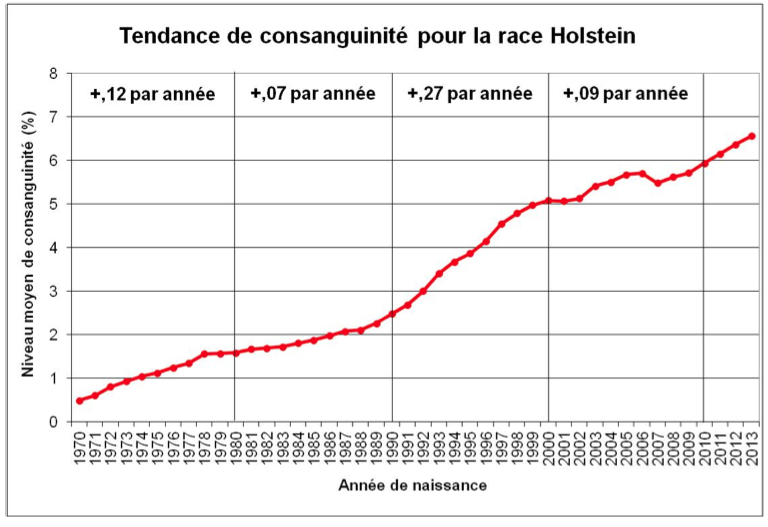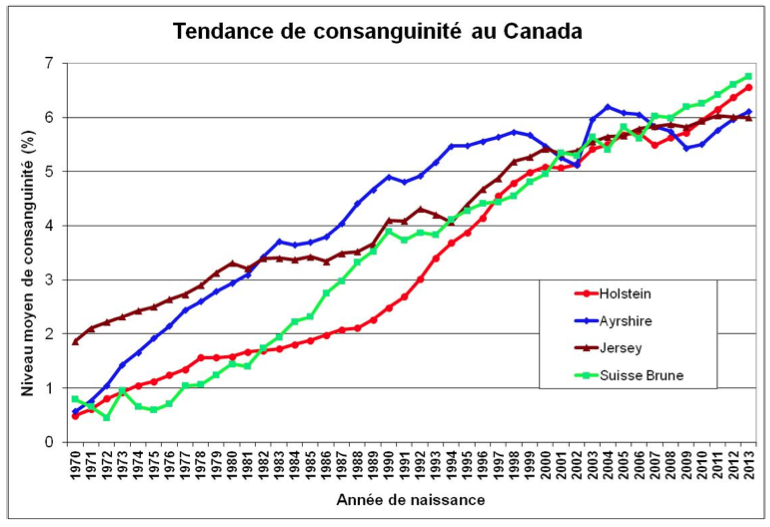Each year, based on official animal registration and pedigree information within its database, Canadian Dairy Network (CDN) computes current statistics related to the level of inbreeding within the Canadian cow population of each dairy breed.
|
Current Inbreeding Level and Change in Average Inbreeding by Breed |
||||||
|
Breed |
Average % Inbreeding for 2013 |
Average Annual Increase in Average Inbreeding Percentage by Time Period |
||||
|
1970- 1980 |
1980- 1990 |
1990- 2000 |
2000- 2010 |
2010- 2013 |
||
|
Ayrshire |
6.11 |
.25 |
.19 |
.10 |
-.02 |
.17 |
|
Brown Swiss |
6.76 |
.02 |
.23 |
.13 |
.14 |
.14 |
|
Canadienne |
8.75 |
.08 |
.28 |
.18 |
.21 |
.17 |
|
Guernsey |
7.36 |
.05 |
.10 |
.21 |
.16 |
.19 |
|
Holstein |
6.56 |
.12 |
.07 |
.27 |
.07 |
.21 |
|
Jersey |
6.00 |
.14 |
.05 |
.16 |
.06 |
.04 |
|
Milking Shorthorn |
2.60 |
.03 |
.00 |
.26 |
-.10 |
.09 |
Among the four major dairy breeds in Canada, all have an average inbreeding level between 6.00% (Jersey) and 6.76% (Brown Swiss) for heifers born in 2013. The Ayrshire breed has well controlled the rate of increase in inbreeding from 2000 to 2010 with an average change of -.02 percentage points per year. In this regard, Jersey and Holstein are also doing reasonably well at +.06% and +.07% per year, respectively. More recently, however, the Jersey trend has been quite stable whereas all other breeds are experiencing a steady increase for animals born since 2010. Among the breeds with the smallest populations in Canada, Canadienne continues to have the highest average inbreeding, now at 8.75% for females born in 2013. Guernsey heifers born in 2013 average 7.36% inbreeding and the average rate of increase during the past few years has also been relatively high at +.19% per year. For Milking Shorthorn, heifers born in 2013 average 2.60% inbreeding based on available pedigree data for the breed but the rate of increase has been slowly on the rise over the past two years.
Below is a graph showing the inbreeding trend for animals of the four largest dairy breeds born in Canada since 1970 as well as a specific graph for the Holstein population alone. For further information, please feel free to contact Canadian Dairy Network (CDN).


Mise à jour sur la Consanguinité – Août 2014 –
Chaque année, selon les enregistrements d’animaux et l’information généalogique officielle dans sa base de données, le Réseau laitier canadien (CDN) effectue le calcul des statistiques récentes associées au niveau de la consanguinité dans la population de vaches canadiennes de chaque race laitière. De cette façon, le niveau moyen de consanguinité pour les animaux nés au cours de l’année civile complétée la plus récente ainsi que les tendances de changement du niveau de consanguinité au fil du temps peuvent être facilement surveillés. Le tableau suivant est basé sur les animaux nés au cours des années depuis 1970 jusqu’à et incluant les animaux enregistrés qui sont nés en 2013.
|
Niveau actuel de consanguinité et le changement dans la moyenne de consanguinité pour chaque race |
||||||
|
Race |
% de consanguinité en 201 |
Moyenne d’accroissement de consanguinité par période |
||||
|
1970- 1979 |
1980- 1989 |
1990- 1999 |
2000- 2010 |
2010- 2013 |
||
|
Ayrshire |
6,11 |
,25 |
,19 |
,10 |
-,02 |
,17 |
|
Suisse Brune |
6,76 |
,02 |
,23 |
,13 |
,14 |
,14 |
|
Canadienne |
8,75 |
,08 |
,28 |
,18 |
,21 |
,17 |
|
Guernsey |
7,36 |
,05 |
,10 |
,21 |
,16 |
,19 |
|
Holstein |
6,56 |
,12 |
,07 |
,27 |
,07 |
,21 |
|
Jersey |
6,00 |
,14 |
,05 |
,16 |
,06 |
,04 |
|
Shorthorn Laitier |
2,60 |
,03 |
,00 |
,26 |
-,10 |
,09 |
Parmi les quatre principales races laitières au Canada, toutes affichent un niveau de consanguinité moyen se situant entre 6,00 % (Jersey) et 6,76 % (Suisse Brune) pour les génisses nées en 2013. La race Ayrshire a bien contrôlé le taux d’augmentation de la consanguinité de 2000 à 2010 avec un changement moyen de -,02 points de pourcentage par année. À cet égard, les races Jersey et Holstein s’en tirent relativement bien avec +,06 % et +,07 % par année, respectivement. Plus récemment, la tendance Jersey a toutefois été assez stable alors que les autres races ont toutes eu une augmentation constante pour les génisses nées depuis 2010. Parmi les races qui possèdent les plus petites populations au Canada, la race Canadienne continue d’afficher la consanguinité moyenne la plus élevée, maintenant à 8,75 % pour les femelles nées en 2013. Les génisses Guernsey nées en 2013 présentent une consanguinité moyenne de 7,36 % et le taux moyen d’augmentation au cours des dernières années a aussi été relativement élevé à +,19 % par année. Dans la race Shorthorn laitière, les génisses nées en 2013 affichent une consanguinité moyenne de 2,60 % basée sur les données généalogiques disponibles pour la race, mais le taux d’augmentation a réalisé une hausse graduelle les deux dernières années.
La page suivante présente un graphique qui illustre la tendance de consanguinité pour les animaux des quatre principales races laitières nés au Canada depuis 1970 et un autre graphique qui se rapporte uniquement à la race Holstein. Pour plus de renseignements, veuillez communiquer avec le Réseau laitier canadien (CDN).


